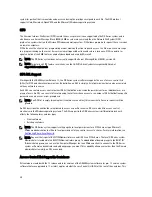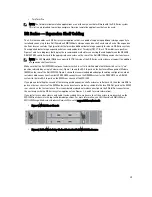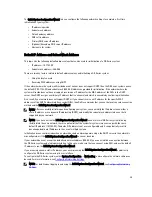
(NTFS) uses ACLs as part of the security descriptor (SD) process, which requires permissions to access such filesystem
objects as files and directories. ACLs support two levels of users:
•
Owners
•
Groups
Both Owners and Groups have Security IDs (SIDs) that define and identify an object owner or the group owning an
object. ACEs in an ACL consist of a SID, a specific permission that either allows or denies access and also defines
which of the following inheritance settings apply:
•
IO—inherit-only: not used for access checking.
•
OI—object inherit: new files get this ACE added.
•
CI—container inherit: new directories get this ACE added.
Windows NTFS ACLs include the following read, write, append, execute, and delete permissions that allow users to:
•
Synchronize access
•
Read data or list the directory
•
Write data or add a file
•
Append data or add a folder
•
Read Extended Attributes (EAs)
•
Write EAs
•
Execute file or traverse folders
•
Delete child or delete folders
•
Delete a file
The Owner user type has two default permissions:
•
Write discretionary ACL
•
Read control
OpenStorage Technology (OST): DR Series System
OpenStorage Technology (OST), was developed by Symantec and provides a logical disk interface for use with network
storage devices. The DR Series system appliance can use OST via plug-in software to integrate its data storage
operations with a number of data management applications (DMAs).
OST allows for better coordination and integration between DR Series system backup, restore, and optimized duplication
operations and the following supported DMA types:
•
NetBackup
•
Backup Exec
Integration is done via a Dell OST plug-in developed for the DR Series system, through which NetBackup and Backup
Exec can control when the backup images are created, duplicated, and deleted. The major benefit of OST is that it
allows the deduplication and compression operations to happen on the client-side so that network traffic can be
reduced.
OST via the Dell OST plug-in allows NetBackup and Backup Exec to take full advantage of such DR Series system
features as data deduplication, replication, and energy efficiency. DR Series systems can access the OpenStorage API
code through the plug-in, which can be installed on the media server platform choice you make (Windows or Linux). The
OST protocol allows the supported backup applications to communicate directly with the DR Series system and
determine whether a specific chunk of data already exists on the system. This process means that if the data already
23
Summary of Contents for PowerVault DX6112
Page 1: ...Dell DR Series System Administrator Guide ...
Page 32: ...32 ...
Page 70: ...70 ...
Page 86: ...86 ...
Page 100: ...For more information on Replication schedules see Creating a Replication Schedule 100 ...
Page 114: ...114 ...
















































